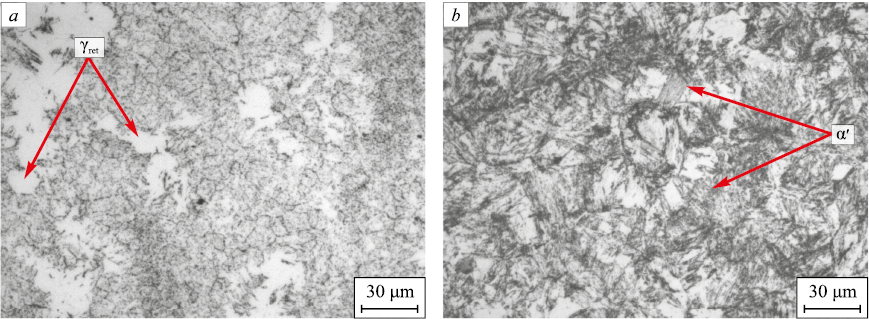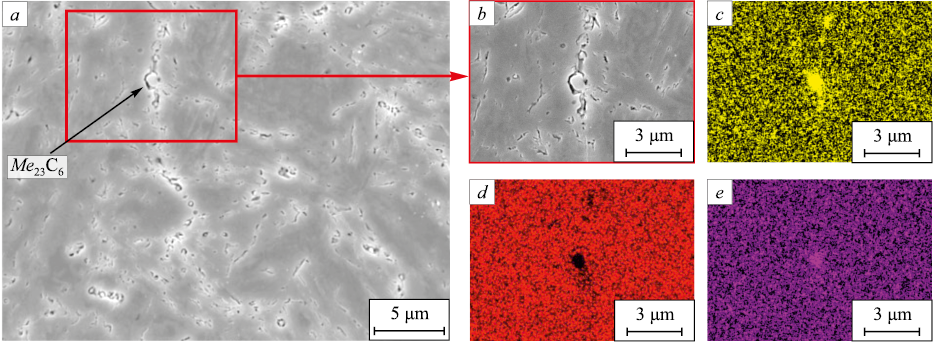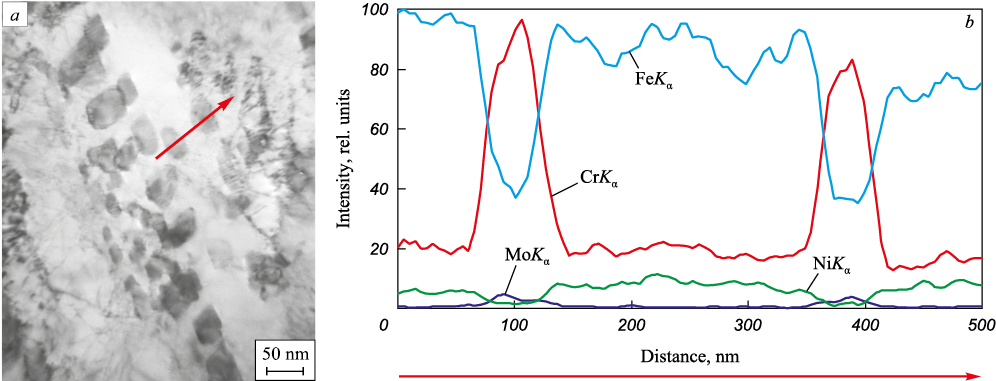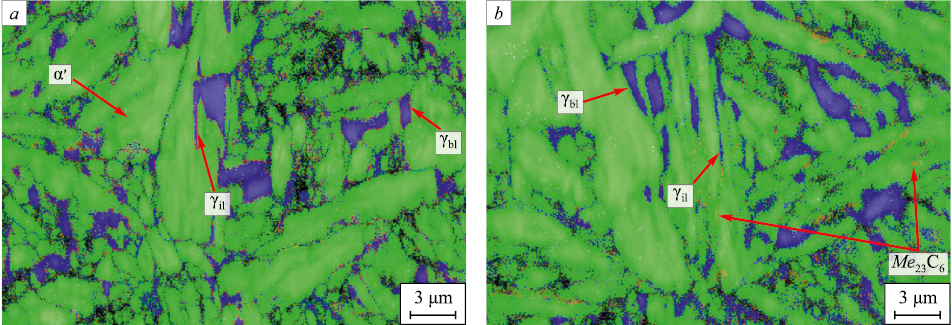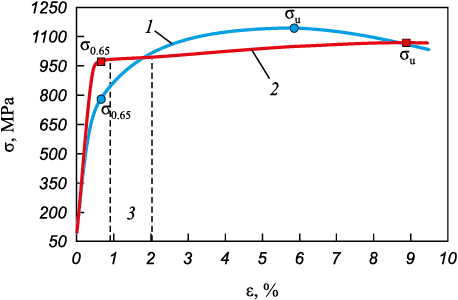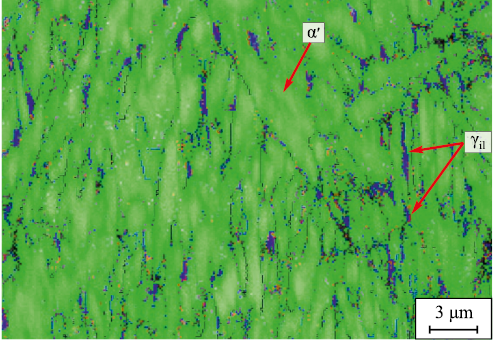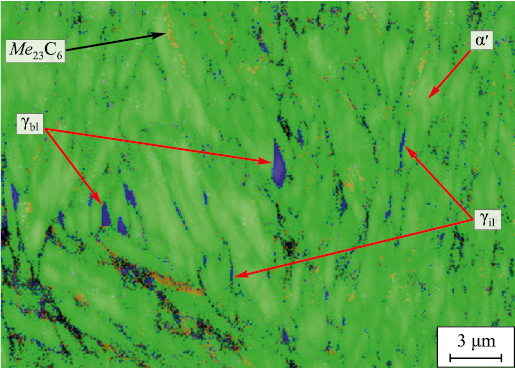Scroll to:
Effect of retained austenite on mechanical properties of steel with 15 % Cr
https://doi.org/10.17073/0368-0797-2023-5-571-579
Abstract
The paper considers the study of influence of retained austenite on the mechanical properties of steel of the austenite-martensitic class based on 15 % Cr after various heat treatment. Significant amount of retained austenite remains in the steel microstructure after quenching and subsequent tempering or heating in the intercritical temperature range that makes difficult to achieve a high yield strength. Destabilization of retained austenite with subsequent transformation into newly formed martensite is provided by multi-stage heat treatment which includes quenching, heating in the intercritical temperature range or above the AC3 point and final tempering. It was established that retained austenite remains in the microstructure of two-phase steel and has the form of blocks and thin layers located in the inter-lath space. Tensile testing of steel based on 15 % Cr showed that multi-stage heat treatment provides a high-strength condition corresponding to strength groups Q125 and Q135. A comparative analysis of deformation behavior of semi-austenitic steel in various states indicates that the beginning of the martensitic transformation after the final tempering shifts into the elastic region during tension and leads to the formation of stress-assisted martensite. It was determined that block-shaped retained austenite in steel with 15 % Cr predominantly undergoes martensitic transformation during tensile and impact tests at a subzero temperature. This is supposed to be the reason for the noticeably lower impact toughness of semi-austenitic steel with 15 % Cr compared to martensitic steel with 13 % Cr at equal strength.
Keywords
For citations:
Pyshmintsev I.Yu., Bityukov S.M., Gusev A.A. Effect of retained austenite on mechanical properties of steel with 15 % Cr. Izvestiya. Ferrous Metallurgy. 2023;66(5):571-579. https://doi.org/10.17073/0368-0797-2023-5-571-579
Introduction
Low-carbon complex alloy steels containing 13 % chromium [1] have proven themselves as corrosion-resistant, high-strength materials used in pipe products within the oil, gas, and energy industries. However, the ongoing exploration of deep deposits (exceeding 4000 m) with elevated СО2 levels, alongside the development of projects for СО2 capture, utilization, and disposal via absorption wells, necessitates enhanced corrosion resistance in steels. This enhancement can be achieved by augmenting the chromium composition. However, an increase in chromium content may potentially prompt the formation of δ ferrite within the steel’s microstructure. This formation adversely affects its visco-plastic properties at both room temperature and sub-zero temperatures, as well as its manufacturability during hot deformation [2]. The emergence of δ ferrite in the steel can be circumvented by introducing austenite-forming elements, such as nickel. Nonetheless, a combined elevation in the levels of chromium and nickel notably lowers the temperature at which martensitic transformation commences, shifting the steel from the martensitic class to the transitional (austenitic–martensitic) class [3 – 6]. Steels classified within the transitional category maintain high strength. However, due to the presence of retained austenite in the martensitic matrix, they exhibit increased ductility and deformability at low temperatures [7 – 11].
The heat treatment of transition class steels involves several operations, starting with quenching at a temperature sufficient to dissolve chromium-based carbides. The next operation aims to convert the majority of austenite into martensite [2; 3; 5]. Various techniques, including cold treatment, are employed to achieve the most comprehensive transformation. However, employing this method in the production of pipe products is deemed impractical.
An alternative approach involves intermediate heating above the Aс3 point, facilitating the controlled release of carbides and consequently elevating the martensitic transformation temperature. The selection of heating temperature is determined by the carbon content and dopants, potentially reaching 780 – 800 °C for steel grade 08Kh17N5M3 [2].
The final tempering process aims to mitigate internal stresses that arise during the formation of “fresh” (untempered) martensite, thereby enhancing ductility and strengthening the material [3; 7].
In high-strength steels, retained austenite typically manifests as blocks or thin layers [12 – 15]. Block austenite in low-alloy high-strength steels exhibits a heightened concentration of carbon, situated adjacent to softer ferrite regions. Conversely, thin layers of austenite are enveloped by hard bainite or martensite laths [14; 16; 17]. Block austenite tends to possess low stability, making it susceptible to undergoing martensitic transformation during deformation [12; 13; 17 – 19]. Thin layers of austenite exhibit greater stability due to the influence of the surrounding lath microstructure of martensite or bainite, impeding the γ → α transformation and creating a “shielding” effect [17; 20 – 22].
The purpose of this research is to investigate the influence exerted by the quantity and morphology of retained austenite on the mechanical properties of 13 and 15 % chromium steel as well as on achievement of strength properties for the Q125 strength category (σu not less than 931 MPa; σ0.65 not less than 862 MPa) and Q135 strength category (σu ≥ 1000 MPa; σ0.65 ≥ 930 MPa) in accordance with State Standard GOST 31446 – 2017.
Materials and methods
The investigation focused on two steels containing 13 and 15 % Cr (Table 1) exhibiting compositions typical for such materials [23 – 25]. Following smelting in a laboratory vacuum induction furnace and subsequent casting, the ingots were heated to 1180 – 1200 °C, maintaining a homogenizing hold.
Table 1. Chemical composition of the studied steels, %
|
Further processing involved hot rolling the ingots into 16 mm diameter rods using a universal mill, implemented in three passes, with a finishing temperature of at least 850 °C. The rods were then air-cooled to reach a temperature of 20 °C. Subsequent tempering of the rods occurred at 620 °C for 1 h.
Austenitization of the steels was conducted in an LH 30/13 electric furnace, with a 30 min hold followed by air cooling. For steel 1, the heating temperature for hardening was 980 °C, whereas for steel 2, it ranged from 900 to 1020 °C. Subsequent heating in the temperature range of 530 to 760 °C was carried out in an electric furnace LAC PP 40/85 for durations of 1 to 2 h, followed by air cooling. To attain the mechanical properties corresponding to strength groups Q125 and Q135, steel 1 underwent tempering at 560 °C for 1.5 h.
The phase composition analysis of the steels was conducted using a Bruker X-ray diffractometer, model D8 ADVANCE, using a cobalt anode. For microstructural examination, a JSM-IT500 scanning electron microscope (SEM) equipped with an inverted electron backscattering diffraction detector (EBSD), and a JEOL JEM-2100Plus transmission electron microscope (TEM) featuring a Bruker XFlash 6TI60 energy-dispersive spectrometer were employed. Chemical etching of SEM samples was performed using the Vilella reagent. TEM foils were prepared from 0.5 mm thick blanks, achieving a final thickness of approximately 100 nm through mechanical thinning and electrolytic polishing at a temperature of –22 ℃.
Tensile mechanical properties were determined according to State Standard GOST 1497 – 84, using cylindrical five-fold samples with a diameter of 6 mm on an MTS Insight universal testing machine. The yield stress was determined at full elongation under a load of 0.65 % in accordance with State Standard GOST 31446 – 2017. The strain rate during the tension was set at 1.67·10\(^–\)3 s\(^–\)1.
Impact bending tests, as per State Standard GOST 9454 – 78, were carried out using a Zwick RKP-450 pendulum impact tester on samples featuring a V notch measuring 55×10×10 mm at a temperature of –40 °С.
Results and discussion
The Potak–Sagalevich structural diagram [2] was employed to determine the phase composition of the steels, offering a more precise evaluation of phase ratios compared to the Scheffler diagram [2]. Steel 1 exhibited a wholly martensitic structure based on the calculated chromium equivalents for ferrite and martensite formation, while steel 2 fell within the austenitic-martensitic classification, displaying an even distribution of structural components. X-ray structural phase analysis in the quenched state revealed negligible austenite presence of no more than 1 % in steel 1. Conversely, steel 2 exhibited varying austenite amounts from 20.9 to 55.5 % with increasing heating temperatures for quenching (Table 2).
Table 2. Influence of hardening temperature on steel 2 phase composition
|
Quenching steel 2 from 960 ℃ aimed to diminish retained austenite and dissolve a significant portion of carbides [26]. Subsequent high tempering within the temperature range of 530 to 590 °C resulted in a marginal reduction in retained austenite content, leading to a lower yield stress (as detailed in Table 3).
Table 3. Influence of heat treatment on phase composition
| ||||||||||||||||||||||||||||||||||||||
Elevated heating within the intercritical temperature region (ICR) up to 680 °C notably destabilized retained austenite, thereby augmenting the yield stress. However, the emergence of “fresh” martensite during cooling noticeably decreased the relative elongation.
The microstructure of steel 2 following high tempering at 590 °C showcased decomposition products of martensite and retained austenite (Fig. 1, a), while heating in the ICR at 680 °C revealed clusters of “fresh” martensite (Fig. 1, b).
Fig. 1. Microstructure of steel 2 after hardening (960 °С) and tempering at 590 °С (a) |
Additionally, the microstructure of steel 2 post-quenching and high tempering contained chromium and molybdenum-based carbides primarily situated in the grain boundary regions (Fig. 2), categorized as carbides of the Me23C6 type.
Fig. 2. Microstructure (a, b) of steel 2 after hardening (960 °С) and tempering (590 °С) |
Given that the yield stress did not meet the necessary criteria for strength groups Q125 and Q135 following the aforementioned heat treatments, steel 2 underwent a multi-stage heat treatment process. This involved hardening from 1020 °C with subsequent air cooling, followed by heating at 760 °C and tempering at 530 °C. Heating at 760 °C induced a reduction in the gamma solid solution in carbon through carbide precipitation and destabilization of austenite. The final tempering phase aimed to alleviate internal stresses by decomposing fresh martensite, thereby enhancing both plasticity and yield stress (Table 4).
Table 4. Influence of multistage heat treatment on phase composition
| |||||||||||||||||
The heating of steel 2 at 760 °C results in the precipitation of carbides exhibiting an equiaxed shape, with sizes ranging between 20 to 150 nm (see Fig. 3). These carbides align with the highly tempered state (Me23C6 ), wherein some chromium atoms are substituted by molybdenum.
Fig. 3. Bright-field image (a) and composition (b) of carbides in microstructure of steel 2 |
An analysis of the phase composition of steel 2 after heating at 760 °C using EBSD revealed a well-defined substructure comprising packets of lath “fresh” martensite (α′) and retained austenite (Fig. 4). The retained austenite manifests in block-like structures (γbl ) and interlayers (γil ) interspersed among martensite laths.
Fig. 4. Phase map of steel 2 microstructure after heating at 760 °С (a) |
Comparative EBSD analysis demonstrated that the final tempering at 530 °C facilitates additional Me23C6 carbides formation, increasing their fraction on the phase map from 1.7 to 2.2 %. Thermo-Calc thermodynamic calculations [26] also support this elevation in carbide fraction at 530 °C. Simultaneously, the fraction of retained austenite diminishes by 1.5 %.
To assess the strengthening mechanisms in the austenitic–martensitic steel, the Orowan relation was applied, considering spherical incoherent non-cut particles uniformly dispersed within a homogeneous microstructure [27]. The contribution of carbides released during the final tempering in the multi-stage heat treatment was estimated using the equation
| \[{\sigma _{\rm{t}}} = \frac{{{{10}^{ - 6}}Gb}}{r}\sqrt[3]{{\frac{{4\pi }}{{3f}}}},\] |
where G is the shear modulus (assumed to be 75·109 Pa for high-alloy martensitic steels); b is the Burgers vector (considered to be 2.49·10\(^–\)10 m); r is the average particle radius (estimated at 40 nm); f is the calculated dimensionless fraction of carbide particles assuming complete separation (based on the full stoichiometry of the carbide (Cr21Mo2 )C6 taken as 0.003. The maximum possible contribution of dispersed particles does not exceed ~45 MPa.
A comparative analysis of the austenitic–martensitic steel behavior during tensile testing at various stages of heat treatment (Fig. 5, curve 1) demonstrates that after quenching from 1020 °C and heating at 760 °C, a pronounced strain hardening occurs, attributed to the partial transformation of retained austenite into deformation martensite. Subsequent tempering at 530 °C results in a noteworthy increase in the yield strength, forming a plateau, accompanied by a reduction in the impact of strain hardening (curve 2).
Fig. 5. Section of tensile stress-deformation diagram of steel 2 in various states: |
X-ray structural phase analysis conducted on the region exhibiting uniform elongation in a tensile-tested sample post-multi-stage heat treatment unveiled a decrease in the proportion of retained austenite from 10.7 to 5.3 %. Examination of the phase map within this region, along a longitudinal section, revealed that austenite predominantly exists in the form of interlath layers (Fig. 6). This suggests a prevailing transformation of retained austenite into a block-like morphology during deformation.
Fig. 6. Phase map of proportional elongation zone of steel 2 |
During the final tempering at 530 °C, there was an additional precipitation of carbides, resulting in reduced carbon content within the gamma solid solution. This reduction in carbon content diminished the stability of retained austenite, leading to its partial transformation into martensite upon subsequent cooling (refer to Table 4). This likely caused a shift in the initiation of martensitic transformation of retained austenite during tension towards the region of elastic deformation. Consequently, stress martensite formation ensued, resulting in a notable increase in the yield stress. The presence of a yield plateau indicates the occurrence of plastic deformation attributed to local slip and martensitic transformation, a characteristic feature observed in steels exhibiting transformation-induced plasticity (TIP steels) [28]. If the formation of martensite during tension primarily arises from the martensitic transformation of austenite with block morphology, localized shear is facilitated by more stable layers of austenite, along which rigid martensite laths can glide [14; 17].
Testing of the steels for impact bending at a temperature of –40 °C was carried out after heat treatment, following the outlined procedures in Table. 5. The examined steels exhibited high impact toughness, meeting the requirements for operation in cold macroclimatic conditions.
Table 5. Impact toughness of the studied steels
|
The notably lower impact toughness observed in the austenitic-martensitic steel with 15 % Cr compared to the martensitic steel with 13 % Cr, despite similar strengths, could be attributed to the limited deformation stability of block austenite. This notion is supported by the phase composition data, indicating a decrease in the fraction of retained austenite in steel 2 near the fracture surface after the impact test, dropping from 10.7 to 8.2 %. The phase map of the austenitic-martensitic steel (Fig. 7) illustrates a significant reduction in the fraction of block morphology of retained austenite, likely due to the partial γ → α′ transformation.
Fig. 7. Phase map of microstructure near the fracture surface of steel 2 |
The computed impact toughness effect of retained austenite, represented as stable interlayers, according to the results of linear approximation [29], shows an insignificant impact when its concentration is below 10 %. The reduction observed in the impact toughness of steel 2 might also be linked to the liberation of carbide phase particles, which negatively impact the resistance against the propagation of brittle cracks [6; 30].
Conclusions
The investigation reveals that quenching of 15 % chromium steel, characterized by a high nickel and molybdenum content, coupled with tempering in the temperature range of 530 to 590 °C, does not yield a high yield stress due to incomplete martensitic transformation and the retention of a considerable quantity of retained austenite (ranging from 30 to 36 %). Even heating the austenitic-martensitic steel in ICR to 680 °C did not meet the desired performance criteria.
However, employing a multi-stage heat treatment procedure involving hardening from 1020 °C, intermediate heating at 760 °C, and final tempering at 530 °C proved effective in reducing the quantity of retained austenite and ensuring mechanical properties aligned with strength groups Q125 and Q135. The precipitation of dispersed Me23C6 carbides (chromium and molybdenum-based) and a reduction in the carbon content within the retained austenite after heating and subsequent tempering led to a decrease its content to 10.7 %.
Post multi-stage heat treatment, retained austenite appears in the microstructure as blocks and interlayers situated between martensite laths. Static tensile testing and subsequent structural-phase analysis unveiled the low stability of block-shaped austenite, which undergoes martensitic transformation under deformation.
It is presumed that the reduction in carbon content within the gamma solid solution due to the final tempering at 530 °C shifted the process of martensitic transformation of retained austenite during static tension into the elastic deformation region. This leads to the formation of stress assisted martensite and a significant increase in the yield stress. Due to the stability of the inter-lath layers of retained austenite, enabling local sliding of surrounding laths, this steel exhibits higher relative elongation compared to martensitic steel with 13 % Cr.
The limited deformation stability of block-shaped retained austenite appears to underlie the reduced impact toughness when contrasted with steel possessing a homogeneous martensitic microstructure.
References
1. ANSI/API Spec 5CRA. Specification for corrosion-resistant alloy seamless tubes for use as casing, tubing, and coupling stoc. American Petroleum Institute; 2010:100.
2. Potak Ya.M. High-Strength Steels. Moscow: Metallurgiya; 1972:208. (In Russ.).
3. Pickering F.B. Physical Metallurgy and the Design of Steels. Applied Science Publishers; 1978:275.
4. Pomerantseva S.I., Voznesenskaya N.M., Tarasenko LV., Lashchevskii V.B., High-strength corrosion-resistant semi-austenitic steels VNS-5 and SN-3. Voprosy aviatsionnoi nauki i tekhniki. Aviatsionnye materialy. 1986;(High-strength steels):65–72. (In Russ.).
5. Potak Ya.M., Sachkov V.V., Popova L.S., Lavrov V.I. Stainless steel Kh16N6 (SN-2A, EP288) of transition class with high viscosity. Metal Science and Heat Treatment. 1968;(11):4–7. (In Russ.).
6. Voznesenskaya N.M., Petrakov А.F., Kablov Е.N., Shal’kevich А.B. High-strength corrosion-resistant steels of austenitic-martensitic class. Metal Science and Heat Treatment. 2002;(7):34–37. (In Russ.).
7. Pomerantseva S.I., Voznesenskaya N.M., Lashchevskii V.B., Gurvich L.Ya. Effect of heating at 400-450℃ on the stress corrosion cracking resistance of welded joints of high-strength stainless steels. Voprosy aviatsionnoi nauki i tekhniki. Aviatsionnye materialy. 1988;(Corrosion and protection of metallic materials and structures):22–26. (In Russ.).
8. Voznesenskaya N.M., Lashchevskii V.B., Gurvich L.Ya., Krivov N.А., Ermolin P.А. Increasing the resistance to corrosion cracking of stamped parts made of steel 08Kh17N5M3. Voprosy aviatsionnoi nauki i tekhniki. Aviatsionnye materialy. 1988;(no. Corrosion and protection of metallic materials and structures):15-21. (In Russ.).
9. Petrakov А.F., Kozlovskaya V.I., Savinkov R.А., Trantsevich Ya.V. Effect of hydrogen on the properties of corrosion-resistant chromium-nickel steels at room and cryogenic temperatures. Voprosy aviatsionnoi nauki i tekhniki. Aviatsionnye materialy. 1985;(3):15–21. (In Russ.).
10. Makhneva Т.М., Dement’ev V.B. Phase composition of VNS2 steel undergone to intensive plastic deformation after hardening and aging in a closed volume. Vestnik IZhGTU. 2009;(4):54-58. (In Russ.).
11. Gromov V.I., Voznesenskaya N.M., Pokrovskaya N.G., Tonysheva O.A. High-strength constructional and corrosion-resistant steels developed by VIAM for aviation engineering. Aviatsionnye materialy i tekhnologii. 2017;(S):159–174. (In Russ.). https://doi.org/10.18577/2071-9140-2017-0-S-159-174
12. Wong A. Modelling the stability and transformation kinetics of retained austenite in steels. Materials Science and Technology. 2022;38(11):676–688. http://dx.doi.org/10.1080/02670836.2022.2063539
13. Xiong X.C., Chen B., Huang M.X., Wang J.F., Wang L. The effect of morphology on the stability of retained austenite in a quenched and partitioned steel. Scripta Materialia. 2013;68(5):321–324. http://dx.doi.org/10.1016/j.scriptamat.2012.11.003
14. Yang K., Ding W., Liu S., Li W., Jin X. Dominating role of film-like carbon-enriched austenite for the simultaneous improvement of strength and toughness in low-carbon steel. Steel Research International. 2021;92(2):2000344. https://doi.org/10.1002/srin.202000344
15. Ghazvinloo H.R., Honarbakhsh-Raouf A., Borhami E. Morphological characteristics of retained austenite in 0.362C–1.38Si–1.24Mn steel processed by one-step quenching and partitioning. Metallurgist. 2016;60:758–764. https://doi.org/10.1007/s11015-016-0363-y
16. Narasimha Rao B.V., Thomas G. Structure-property relations and the design of Fe-4Cr-C base structural steels for high strength and toughness. Metallurgical Transactions A. 1980;11:441–457. https://doi.org/10.1007/bf02654568
17. Maresca F., Kouznetsova V.G., Geers M.G.D. On the role of interlath retained austenite in the deformation of lath martensite. Modelling and Simulation in Materials Science and Engineering. 2014;21:21. https://doi.org/10.1088/0965-0393/22/4/045011
18. Liu W., Zhang B., Zhao A., Guo H., Sun S. Control of morphology and dimension of blocky retained austenite in medium-carbon steel. Material Research Express. 2018;6(1):10. https://doi.org/10.1088/2053-1591/aae561
19. Liu W., Liang J., Liang Y., Zhang B., Zhao A. A study of blocky retained austenite and properties under variously heat-treated ultra-fine bainitic steel. Material Research Express. 2019;6(10):15. https://doi.org/10.1088/2053-1591/ab3937
20. Lu X., Yang Z., Qian D., Lan J., Hua L. Effect of martensite pre-quenching on bainite transformation kinetics, martensite/bainite duplex microstructures, mechanical properties and retained austenite stability of GCr15 bearing steel. Journal of Materials Research and Technology. 2021;15:2429–2438. https://doi.org/10.1016/j.jmrt.2021.09.070
21. Xiao H., Zhao G., Xu D., Cheng Y., Bao S. Effect of microstructure morphology of Q&P steel on carbon and manganese partitioning and stability of retained austenite. Metals. 2022;12(10):1613. https://doi.org/10.3390/met12101613
22. Yi H.L., Chen P., Bhadeshia H.K.D.H. Optimizing the morphology and stability of retained austenite in a d-TRIP steel. Metallurgical and Materials Transactions A. 2014;45: 3512–3518. https://doi.org/10.1007/s11661-014-2267-4
23. Dragunov Yu.G., Zubchenko A.S., Kashirskii Yu.V. Grade Guide of Steels and Alloys. Мoscow. 2014, 1216 p. (In Russ.).
24. Сao L., Anderko A., Gui F., Sridhar N. Localized corrosion of corrosion resistant alloys in H2S-containing environments. Corrosion. 2016;72(5):636–654. https://doi.org/10.5006/2016
25. Kimura M., Tamari T., Shimamoto K. High Cr stainless steel OCTG with high strength and superior corrosion resistance. JFE Technical Report. 2005;(9):7–12.
26. Pumpyanskii D.A., Pyshmintsev I.Yu., Bityukov S.M., Gervas’ev M.A., Gusev A.A. Features of microstructure, phase composition and strengthening capability of stainless steels with 13 – 17% Cr. Izvestiya. Ferrous Metallurgy. 2022;65(9):644–653. (In Russ.). https://doi.org/10.17073/0368-0797-2022-9-644-653
27. Shtremel М.А. Strength of Alloys. Part II. Deformation. Мoscow: MISIS; 1997:527. (In Russ.).
28. Gervasyev M.A., Estemirova S.K., Mushnikov A.N., Sharapova V.A., Gusev A.A., Bashirova M.A., Mushnikov A.N. Changes in the phase composition of high-manganese steels during tensile deformation. The Physics of Metals and Metallography. 2022;(1):32–36. https://doi.org/10.31857/S0015323022010053
29. Nakagawa H., Miyazaki T. Effect of retained austenite on the microstructure and mechanical properties of martensitic precipitation hardening stainless steel. Journal of Materials Science. 1999;34:3901–3908. https://doi.org/10.1023/A:1004626907367
30. Pyshmintsev I.Yu., Smirnov M.А., Laev K.А., Khramkov E.V., Alyutin D.M. Properties of high-chromium corrosion-resistant steels exposed to high-temperature thermomechanical treatment. Vestnik Magnitogorskogo gosudarstvennogo tehnitseskogo universiteta im. G.I. Nosova. 2015;(3):78–82. (In Russ.).
About the Authors
I. Yu. PyshmintsevRussian Federation
Igor’ Yu. Pyshmintsev, Dr. Sci. (Eng.), Prof., General Director
5 Bol’shoi Blvd.., Skolkovo, Moscow 143026, Russian Federation
S. M. Bityukov
Russian Federation
Sergei M. Bityukov, Cand. Sci. (Eng.), Head of the Laboratory
5 Bol’shoi Blvd.., Skolkovo, Moscow 143026, Russian Federation
A. A. Gusev
Russian Federation
Aleksei A. Gusev, Junior Researcher
5 Bol’shoi Blvd.., Skolkovo, Moscow 143026, Russian Federation
Review
For citations:
Pyshmintsev I.Yu., Bityukov S.M., Gusev A.A. Effect of retained austenite on mechanical properties of steel with 15 % Cr. Izvestiya. Ferrous Metallurgy. 2023;66(5):571-579. https://doi.org/10.17073/0368-0797-2023-5-571-579


